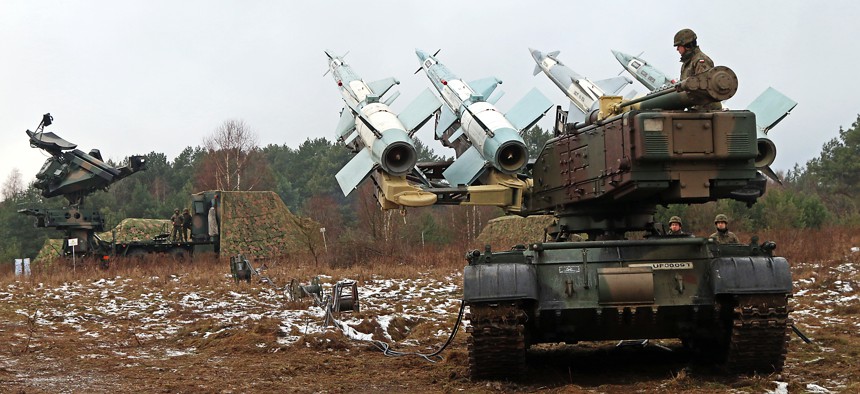
Polish soldiers demonstrate the W125 launcher SC Anti-missile system, Jan. 14, at Skwierzyna, Poland. U.S. Army photo by Sgt. Paige Behringer
Eyeing Russia, Poland Wants More NATO Troops
But does it want anti-missile interceptors? How about the F-35?
With a nervous eye toward Russia, Poland’s president is asking NATO to keep more troops on its territory.
“It [the troops] may be of the rotational nature, but I would like to make sure that it is so intensive as to avoid such days on which there are no NATO forces in the territory of Poland,” President Andrzej Duda told reporters at the German Marshall Fund in Washington Wednesday.
Duda, who was elected president last year, was continuing the calls of the previous Polish government, which was unnerved by Russia’s 2014 invasion of Ukraine.
The U.S. has been sending military forces to Poland and other nations in the region for more frequent training as part of the European Reassurance Initiative, the Obama administration’s attempt to ease NATO’s elevated fears. This week, Pentagon officials announced plans to send more tanks and armored vehicles to Europe and rotate troops as part of the initiative. Poland will host some of the equipment.
Poland also has plans to buy missile defense interceptors, but Duda’s government is said to be rethinking that decision. Last April, the previous government chose Raytheon’s Patriot missile defense system. But now Polish officials are debating whether missile defenses would be worth buying at all, since they would likely be overwhelmed by a combination of Russian missiles and aircraft, said Jacek Bartosiak, an analyst at the Poland-based Jagiellonian Club think tank and senior fellow at Potomac Foundation in Virginia.
“These are issues which will be decided by the experts and I’m leaving those decisions to them,” Duda said. “The only thing I want to have is an efficient missile defense. As long as it is effective, I’m OK with it.”
For Poland, low-flying Russian missiles that never leave the Earth’s atmosphere are “very much a strategic concern,” said Tom Karako, a missile defense expert at the Center for Strategic and International Studies. American military brass have been increasingly concerned about these types of Russian cruise missiles.
The U.S. is also planning to install SM-3 missile interceptors in Poland by 2018, part of the Obama administration’s European missile defense shield. But the so-called “Phased Adaptive Approach,” is largely geared toward shooting down Iranian long-range ballistic missiles that leave the Earth’s atmosphere and then reenter near the target, Karako said.
“We and our NATO allies have a shared reason to move not just to ICBM-killers, but to more lower-tier defenses that frankly can be effective in deterring conventional Russian aggression,” Karako said.
That means NATO could look to shoot down lower-flying missiles with interceptors such as the Patriot, Raytheon’s SM-6, and Lockheed’s Medium Extended Air Defense System.
“If you want to deter Russia, you want to deter the multiplicity of missiles that they have,” Karako said.
Bartosiak said Poland needs more than its current 48 F-16 fighter jets. One way of bolstering its defense is by acquiring and upgrading retired American F-16s.
“If we had approximately 200 of those, we would have a real air force capability,” he said, noting that Poland could overhaul the planes domestically.
The Polish air force could also use more JASSMs, stealthy cruise missiles built by Lockheed, Bartosiak said.
And is the F-35 Joint Strike Fighter on Poland’s wish list?
“I wouldn’t want to use the word ‘wish’ in the context of the wish list,” Duda said when asked. “I would like to take a [full] view of what is able to guarantee security to us in our part of Europe to the highest possible extent.”





